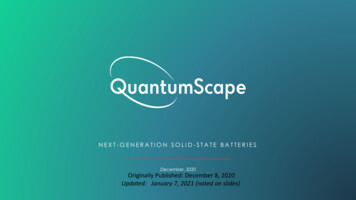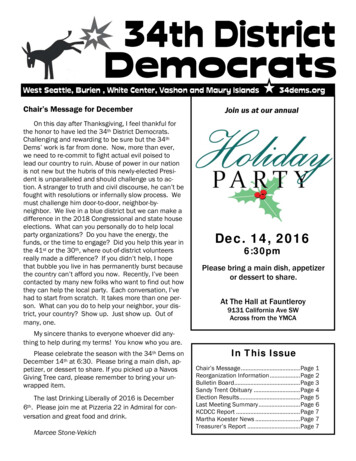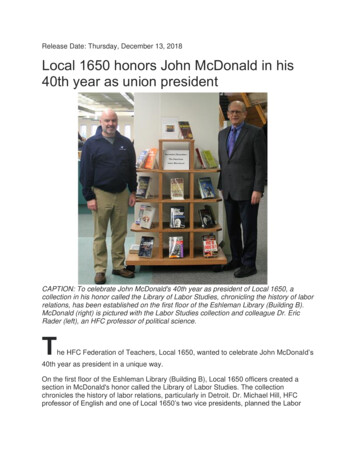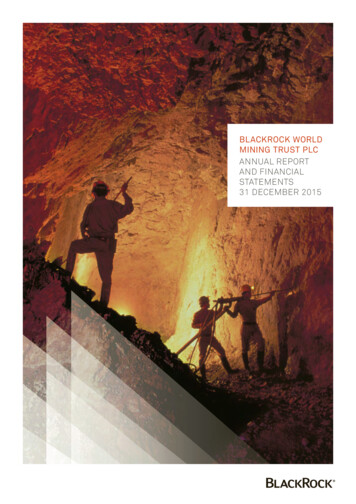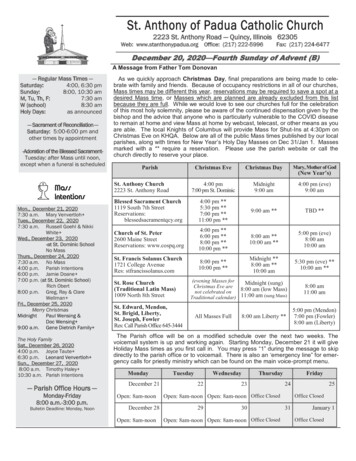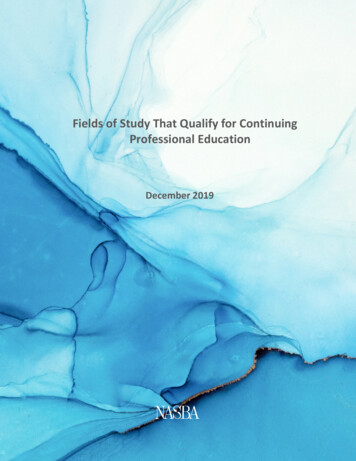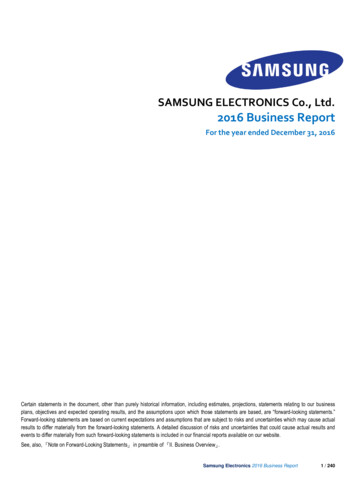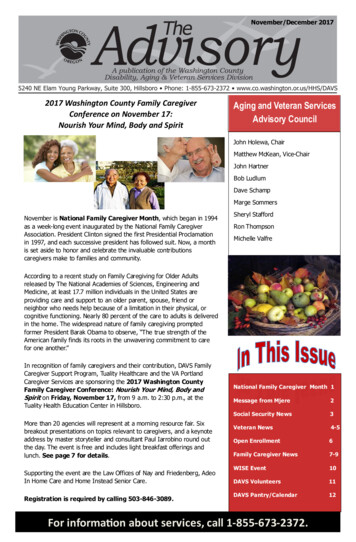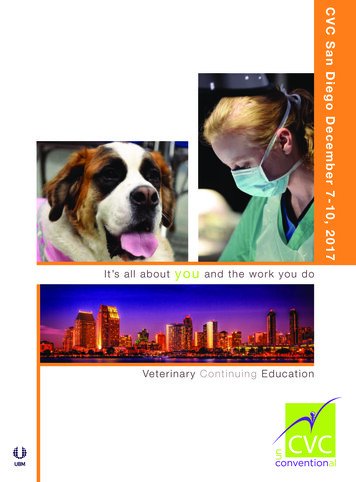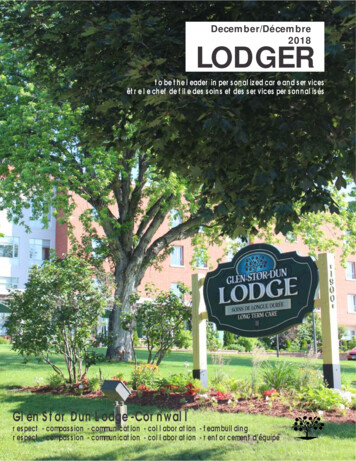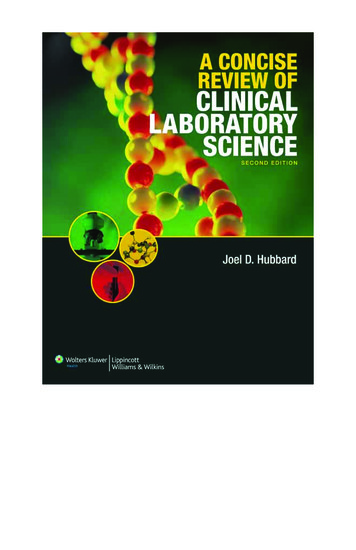
Transcription
P1: PBULWBK192-FMLWBK192-HubbardDecember 2, 2008A Concise Reviewof ClinicalLaboratory ScienceSecond Editioni13:43
P1: PBULWBK192-FMLWBK192-HubbardDecember 2, 2008ii13:43
P1: PBULWBK192-FMLWBK192-HubbardDecember 2, 2008A Concise Reviewof ClinicalLaboratory ScienceSecond EditionJoel D. Hubbard, PhD, MT (ASCP)Associate Professor, Program of Clinical Laboratory ScienceDepartment of Laboratory Sciences and Primary CareSchool of Allied Health SciencesTexas Tech University Health Sciences CenterLubbock, Texasiii13:43
P1: PBULWBK192-FMLWBK192-HubbardDecember 2, 2008Acquisitions Editor: John GoucherManaging Editor: Meredith BrittainProject Manager: Rosanne HallowellManufacturing Manager: Margie OrzechMarketing Manager: Allison NoplockCover Designer: Melissa WalterDesign Coordinator: Stephen DrudingProduction Services: Aptara, Inc.c 2010 by LIPPINCOTT WILLIAMS & WILKINS, a Wolters Kluwer business c 1997 by WILLIAMS & WILKINS 530 Walnut StreetPhiladelphia, PA 19106All rights reserved. This book is protected by copyright. No part of this book may be reproduced in any form or byany means, including photocopying, or utilized by any information storage and retrieval system without writtenpermission from the copyright owner, except for brief quotations embodied in critical articles and reviews. Torequest permission, please contact Lippincott Williams & Wilkins at 530 Walnut Street, Philadelphia, PA 19016, viaemail at permissions@lww.com or via our website at lww.com (products and services).Printed in the United States of America.Library of Congress Cataloging-in-Publication DataA concise review of clinical laboratory science / [edited by] Joel Hubbard.—2nd ed.p. ; cm.Includes index.ISBN 978-0-7817-8202-91. Medical laboratory technology—Examinations, questions, etc. 2. Medical laboratory technology—Outlines,syllabi, etc. I. Hubbard, Joel D. (Joel David), 1952[DNLM: 1. Laboratory Techniques and Procedures–Examination Questions. QY 18.2 C744 2010]RB38.25.H83 2010616.07 56—dc222008043981DISCLAIMERCare has been taken to confirm the accuracy of the information presented and to describe generally acceptedpractices. However, the authors, editors, and publisher are not responsible for errors or omissions or for anyconsequences from application of the information in this book and make no warranty, expressed or implied, withrespect to the currency, completeness, or accuracy of the contents of the publication. Application of this informationin a particular situation remains the professional responsibility of the practitioner; the clinical treatments describedand recommended may not be considered absolute and universal recommendations.The authors, editors, and publisher have exerted every effort to ensure that drug selection and dosage set forth in thistext are in accordance with recommendations and practice at the time of publication. However, in view of ongoingresearch, changes in government regulations, and the constant flow of information relating to drug therapy and drugreactions, the reader is urged to check the package insert for each drug for any change in indications and dosage andfor added warnings and precautions. This is particularly important when the recommended agent is a new orinfrequently employed drug.Some drugs and medical devices presented in this publication have Food and Drug Administration (FDA) clearancefor limited use in restricted research settings. It is the responsibility of the clinician to ascertain the FDA status ofeach drug or device planned for use in their clinical practice.The publishers have made every effort to trace copyright holders for borrowed material. If they have inadvertentlyoverlooked any, they will be pleased to make the necessary arrangements at the first opportunity.To purchase additional copies of this book, call our customer service department at (800) 638-3030 or fax orders to(301) 223-2320. International customers should call (301) 223-2300. Visit Lippincott Williams & Wilkins on theInternet at: LWW.com. Lippincott Williams & Wilkins customer service representatives are available from 8:30 amto 6:00 pm, EST.10 9 8 7 6 5 4 3 2 1iv13:43
P1: PBULWBK192-FMLWBK192-HubbardDecember 2, 2008This book is dedicated to clinical laboratory science students everywhere.In your upcoming role as professionals, remember that your job isimportant to the medical world as well as to the individual patient.Be proud of the fact that you will be making a differencein people’s lives. Always be excited about the unlimited opportunitiesavailable in your chosen profession and help lead the fieldof Clinical Laboratory Science well into the 21st century.v13:43
P1: PBULWBK192-FMLWBK192-HubbardDecember 2, 2008vi13:43
P1: PBULWBK192-FMLWBK192-HubbardDecember 2, 2008PREFACEThe arrival of the second edition of A Concise Review of Clinical Laboratory Sciencehas long been anticipated by students and educators alike. This review text is a valuableeducational tool for both the novice and the experienced clinical laboratory scientist. Itis designed to be an updated and concise review of all disciplines of clinical laboratoryscience and will also serve as a tool for students of clinical laboratory science studying fornational certification examinations, including the American Society of Clinical PathologistsBoard of Registry exam, the National Certification Agency (NCA) exam, and the AmericanMedical Technologist (AMT) exam. Practicing clinical laboratory scientists and medicalresidents will also find this book to be an excellent source for review.This book represents a culmination of the efforts and expertise of the faculty of theClinical Laboratory Science program at Texas Tech University Health Sciences Center inLubbock, Texas, and reflects over 100 years of combined medical technology experience.All contributing authors reflect their professional excellence in their contributed chapters,not only as educators, but also as outstanding professionals in their field. I encourage readersto send me feedback on this book at the following email address: joel.hubbard@ttuhsc.edu.Text Format and FeaturesEach chapter presents a concise summary of the most important facts and concepts in thatsubject area in an outline format. Key points appear in bold for easy reference. Boxes,tables, and figures throughout distill concepts and make them easier to comprehend. Onlinemenus at the end of each chapter point readers to supplementary Web-based materials.What’s New in This EditionThe second edition includes the most current and updated information. An expanded chapter dealing with laboratory operations (Chapter 11) addresses topics such as managementand organizational theory, professionalism, quality assurance, laboratory regulations, anddelivery of an educational unit. In addition, a new chapter on molecular pathology (Chapter10) focuses on molecular laboratory methods and an overview on the testing of geneticdiseases.Additional ResourcesA Concise Review of Clinical Laboratory Science, second edition, includes additional resources for both instructors and students that are available on the book’s companion Website at thePoint.lww.com/Hubbard2e.vii13:43
P1: PBULWBK192-FMLWBK192-HubbardviiiDecember 2, 2008PrefaceInstructorsApproved adopting instructors will be given access to the following additional resources:r Image Bank (including color images referenced in the text)r Quiz Bankr Web Case Studies (including those referenced in the text)StudentsStudents who have purchased A Concise Review of Clinical Laboratory Science, secondedition, have access to the following additional resources:r Image Bank (including color images referenced in the text)r Quiz Bankr Web Case Studies (including those referenced in the text)In addition, purchasers of the text can access the searchable Full Text Online by goingto the A Concise Review of Clinical Laboratory Science, second edition, Web site atthePoint.lww.com/Hubbard2e. See the inside front cover of this text for more details, including the pass code you will need to gain access to the Web site.13:43
P1: PBULWBK192-FMLWBK192-HubbardDecember 2, 2008ACKNOWLEDGMENTSI would like to thank all of the following contributing authors—Dr. Lynne Hamilton, Dr.Hal Larsen, Dr. Barbara Sawyer, Mr. Wade Redman, Ms. Lori Rice-Spearman, and Dr.Tootie Tatum—for making this book possible. Their individual expertise, willingness topresent the highest quality of material, and high level of professionalism made the task ofproducing this text easy. I would also like to thank my wife, Kathy, who patiently listenedto my endless rambling about the project.ix13:43
P1: PBULWBK192-FMLWBK192-HubbardDecember 2, 2008x13:43
P1: PBULWBK192-FMLWBK192-HubbardDecember 2, 2008CONTRIBUTORSLynne Hamilton, PhD, MT (ASCP)Assistant Professor, Program of Clinical LaboratoryScienceDepartment of Laboratory Sciences and PrimaryCareSchool of Allied Health SciencesTexas Tech University Health Sciences CenterLubbock, TexasJoel D. Hubbard, PhD, MT (ASCP)Associate Professor, Program of Clinical LaboratoryScienceDepartment of Laboratory Sciences and PrimaryCareSchool of Allied Health SciencesTexas Tech University Health Sciences CenterLubbock, TexasHal S. Larsen, MT (ASCP), CLS (NCA), PhDProfessor and Chair, Department of Diagnostic andPrimary CareSchool of Allied Health SciencesTexas Tech University Health Sciences CenterLubbock, TexasWade Redman, MT (ASCP), MBAAssistant Professor, Program of Clinical LaboratoryScienceDepartment of Laboratory Sciences and PrimaryCareSchool of Allied Health SciencesTexas Tech University Health Sciences CenterLubbock, TexasLori Rice-Spearman, MS, MT (ASCP)Associate Professor andProgram Director of Clinical Laboratory ScienceDepartment of Laboratory Sciences and PrimaryCareSchool of Allied Health SciencesTexas Tech University Health Sciences CenterLubbock, TexasBarbara Sawyer, PhD, MT (ASCP),CLS (NCA), CLSp (MB)Professor, Department of Laboratory Sciences andPrimary CareSchool of Allied Health SciencesTexas Tech University Health Sciences CenterLubbock, TexasOwatha L. Tatum, PhD, CLSp (MB),MP (ASCP)Assistant Professor, Program of Clinical LaboratoryScienceDepartment of Laboratory Sciences and PrimaryCareSchool of Allied Health SciencesTexas Tech University Health Sciences CenterLubbock, Texasxi13:43
P1: PBULWBK192-FMLWBK192-HubbardDecember 2, 2008xii13:43
P1: PBULWBK192-FMLWBK192-HubbardDecember 2, 2008CONTENTSCHAPTER 1CHAPTER 2Clinical Chemistry. . . . . . . . . . . . . . . . . . . . . . . . . . . . . . . . . . . . . . . .1Barbara SawyerI. Clinical Chemistry Basics . . . . . . . . . . . . . . . . . . . . . . . . . . . . . . . . . . . . . . . . . . . . . . . . .II. Special Methods in Clinical Chemistry . . . . . . . . . . . . . . . . . . . . . . . . . . . . . . . . . . . . . .III. Basic Anatomy and Physiology . . . . . . . . . . . . . . . . . . . . . . . . . . . . . . . . . . . . . . . . . . . .IV. Analytes and Pathophysiology . . . . . . . . . . . . . . . . . . . . . . . . . . . . . . . . . . . . . . . . . . . . .V. Enzymology . . . . . . . . . . . . . . . . . . . . . . . . . . . . . . . . . . . . . . . . . . . . . . . . . . . . . . . . . . . . .VI. Endocrinology . . . . . . . . . . . . . . . . . . . . . . . . . . . . . . . . . . . . . . . . . . . . . . . . . . . . . . . . . . .VII. Toxic and Therapeutic Drugs . . . . . . . . . . . . . . . . . . . . . . . . . . . . . . . . . . . . . . . . . . . . . .171014303546Hemostasis and Coagulation . . . . . . . . . . . . . . . . . . . . . . . . . . . . . . 52Joel HubbardI. Platelet Physiology . . . . . . . . . . . . . . . . . . . . . . . . . . . . . . . . . . . . . . . . . . . . . . . . . . . . . . .II. Platelet Pathophysiology . . . . . . . . . . . . . . . . . . . . . . . . . . . . . . . . . . . . . . . . . . . . . . . . . .III. Blood Coagulation and Fibrinolysis . . . . . . . . . . . . . . . . . . . . . . . . . . . . . . . . . . . . . . . .IV. Coagulation Disorders . . . . . . . . . . . . . . . . . . . . . . . . . . . . . . . . . . . . . . . . . . . . . . . . . . . .CHAPTER 352556676Routine Hematology . . . . . . . . . . . . . . . . . . . . . . . . . . . . . . . . . . . . . . 85Joel HubbardI. Laboratory Analysis . . . . . . . . . . . . . . . . . . . . . . . . . . . . . . . . . . . . . . . . . . . . . . . . . . . . . . 85II. Hematopoietic Tissues . . . . . . . . . . . . . . . . . . . . . . . . . . . . . . . . . . . . . . . . . . . . . . . . . . . . 94III. Hemoglobin Synthesis, Structure, and Function . . . . . . . . . . . . . . . . . . . . . . . . . . . . . . 99IV. Erythrocytes and Erythropoiesis . . . . . . . . . . . . . . . . . . . . . . . . . . . . . . . . . . . . . . . . . . . . 104CHAPTER 4Hematologic Disorders . . . . . . . . . . . . . . . . . . . . . . . . . . . . . . . . . . . 117Joel HubbardI. Red Blood Cell Indices and Their Use in the Diagnosis of Anemia . . . . . . . . . . . . .II. Red Blood Cell (RBC) Disorders . . . . . . . . . . . . . . . . . . . . . . . . . . . . . . . . . . . . . . . . . . .III. Anemias and Polycythemias . . . . . . . . . . . . . . . . . . . . . . . . . . . . . . . . . . . . . . . . . . . . . . .IV. Leukocyte Disorders . . . . . . . . . . . . . . . . . . . . . . . . . . . . . . . . . . . . . . . . . . . . . . . . . . . . . .V. Lymphocyte Physiology and Disorders . . . . . . . . . . . . . . . . . . . . . . . . . . . . . . . . . . . . . .117118120145164xiii13:43
P1: PBULWBK192-FMLWBK192-HubbardxivDecember 2, 2008ContentsCHAPTER 5Immunology and Serology . . . . . . . . . . . . . . . . . . . . . . . . . . . . . . . . 177Wade Redman and Joel HubbardI. Introduction . . . . . . . . . . . . . . . . . . . . . . . . . . . . . . . . . . . . . . . . . . . . . . . . . . . . . . . . . . . . . .II. Cells and Tissues of the Immune System . . . . . . . . . . . . . . . . . . . . . . . . . . . . . . . . . . . .III. Immunity . . . . . . . . . . . . . . . . . . . . . . . . . . . . . . . . . . . . . . . . . . . . . . . . . . .
Students who have purchased A Concise Review of Clinical Laboratory Science, second edition, have access to the following additional resources: Image Bank (including color images referenced in the text) Quiz Bank Web Case Studies (including those referenced in the text) In addition, purchasers of the text can access the searchable Full Text Online by going to the A Concise Review of Clinical .
